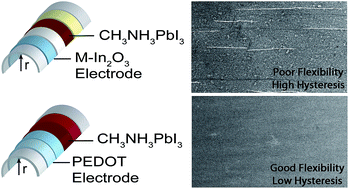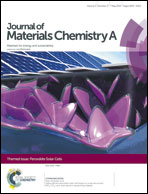Fatigue resistance of a flexible, efficient, and metal oxide-free perovskite solar cell†
Abstract
Although the high efficiencies of perovskite solar cells have attracted the most attention from the photovoltaic community, one of their most attractive attributes is that flexible devices can be prepared by depositing the perovskite on plastic substrates using solution-based processing techniques. Highly flexible devices have the potential to be fabricated through roll-to-roll manufacturing, which is a fast and easy method for light weight thin-film solar cell production. In order to determine the flexibility of these perovskite-based devices, we have carried out fatigue resistance measurements on flexible perovskite solar cells by bending the devices over a cylinder with a 4 mm radius of curvature for up to 2000 cycles. We show that the main reason for the drop in performance of these devices is the formation of cracks in the indium oxide-based transparent conductive electrode. To improve device flexibility, we substituted the metal oxide electrode with a layer of highly conductive poly(3,4-ethylenedioxythiophene):poly(styrene sulfonate) (PEDOT:PSS). The resulting devices were entirely metal oxide free, and displayed power conversion efficiencies as high as 7.6% with very little hysteresis. By comparing the fatigue resistances of these metal oxide-free devices with those of polymer-based solar cells, we were able to evaluate the inherent flexibility of CH3NH3PbI3 films for the first time.

- This article is part of the themed collections: 2015 Journal of Materials Chemistry A Hot Papers and Perovskite Solar Cells

 Please wait while we load your content...
Please wait while we load your content...